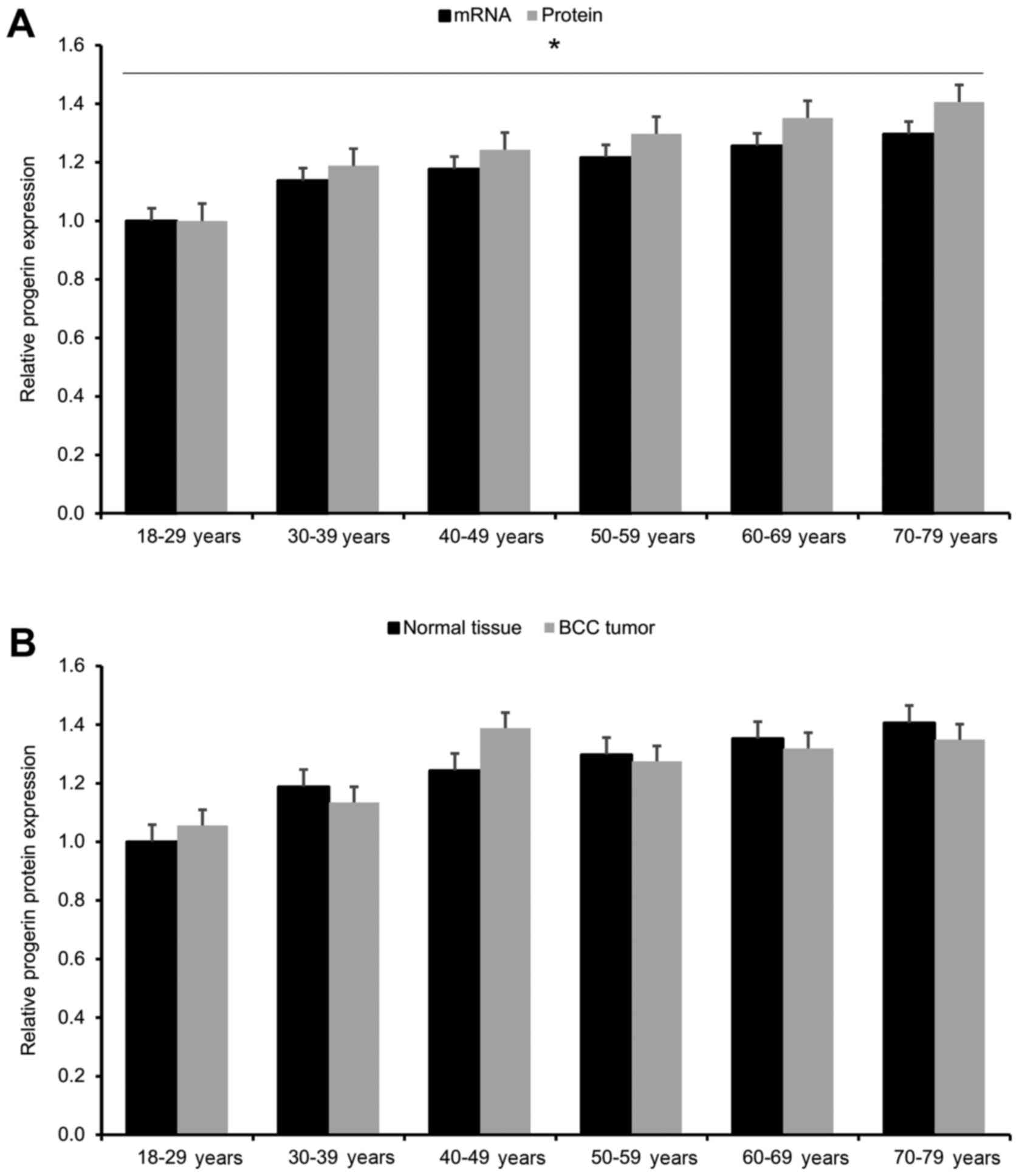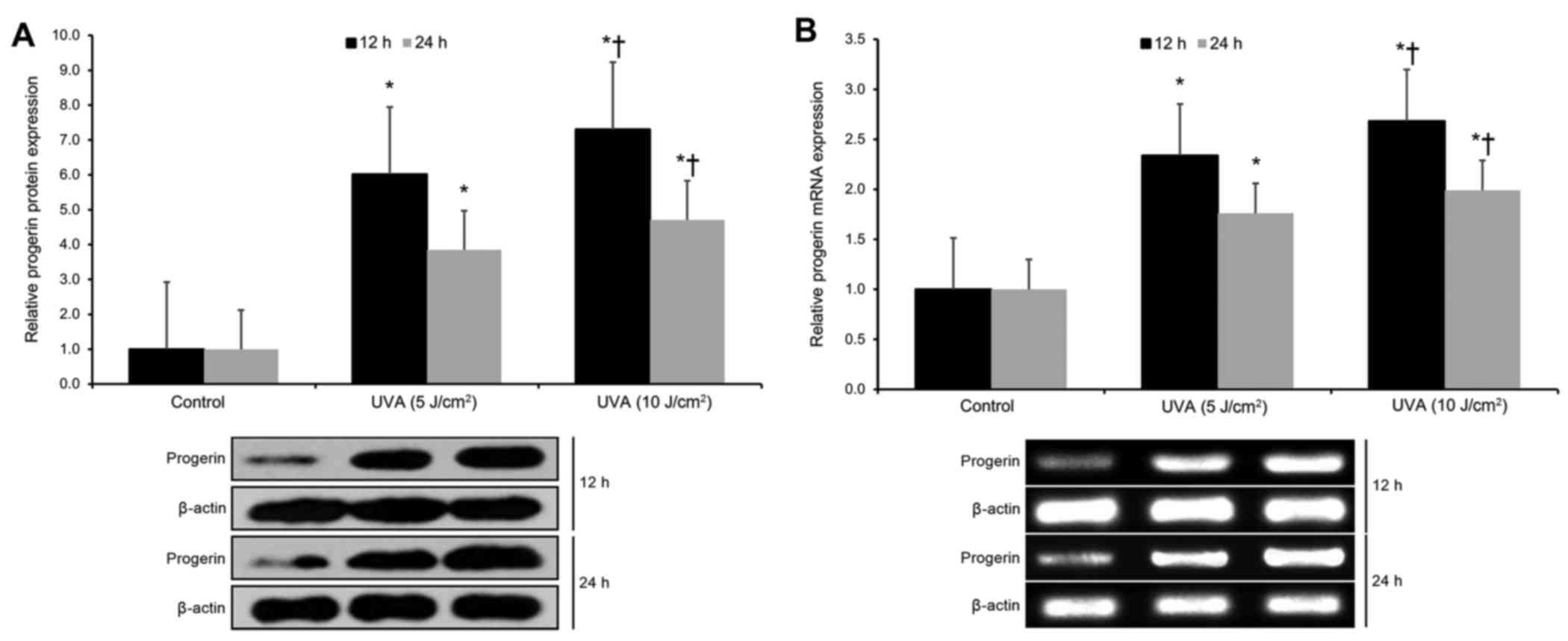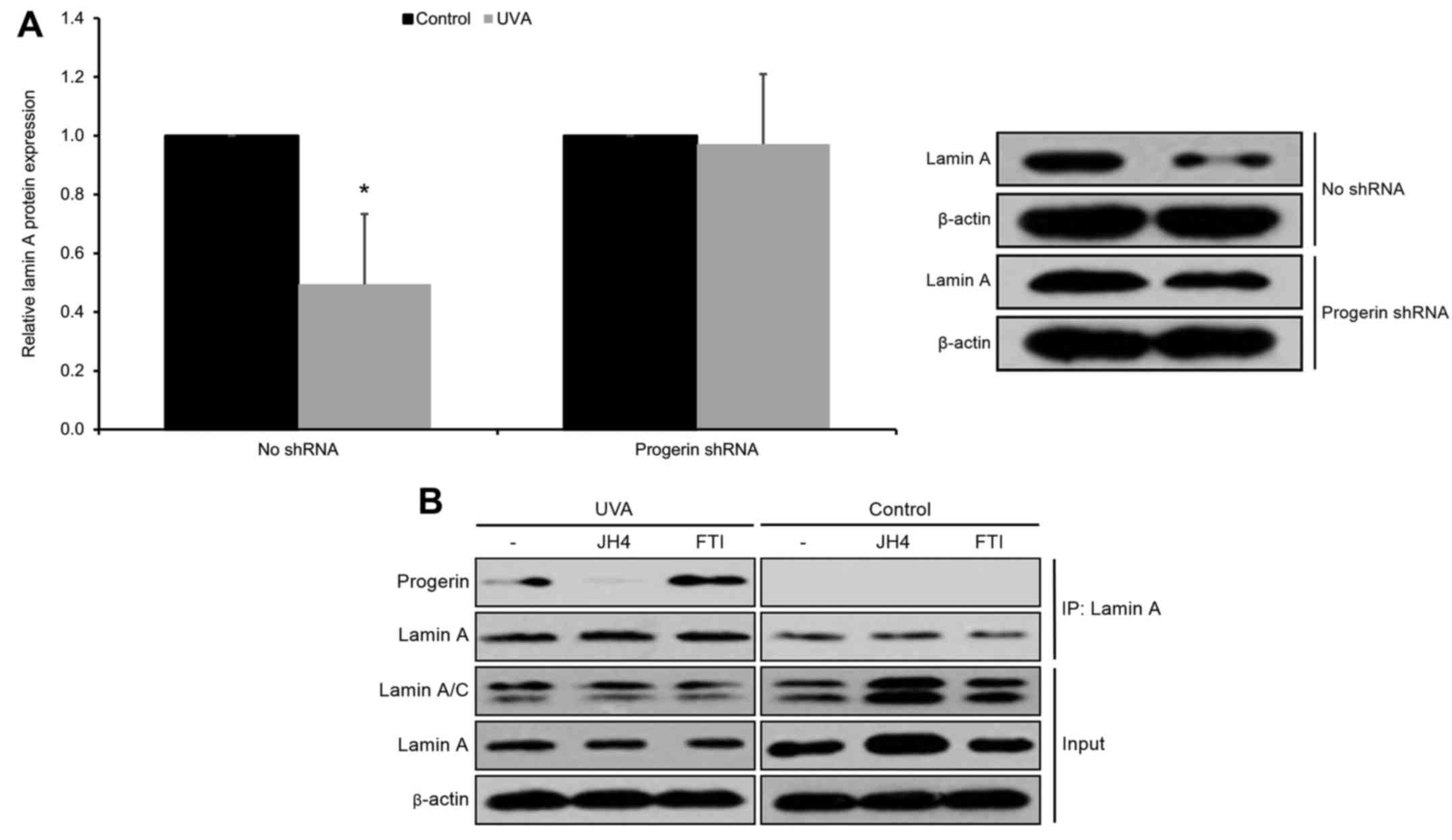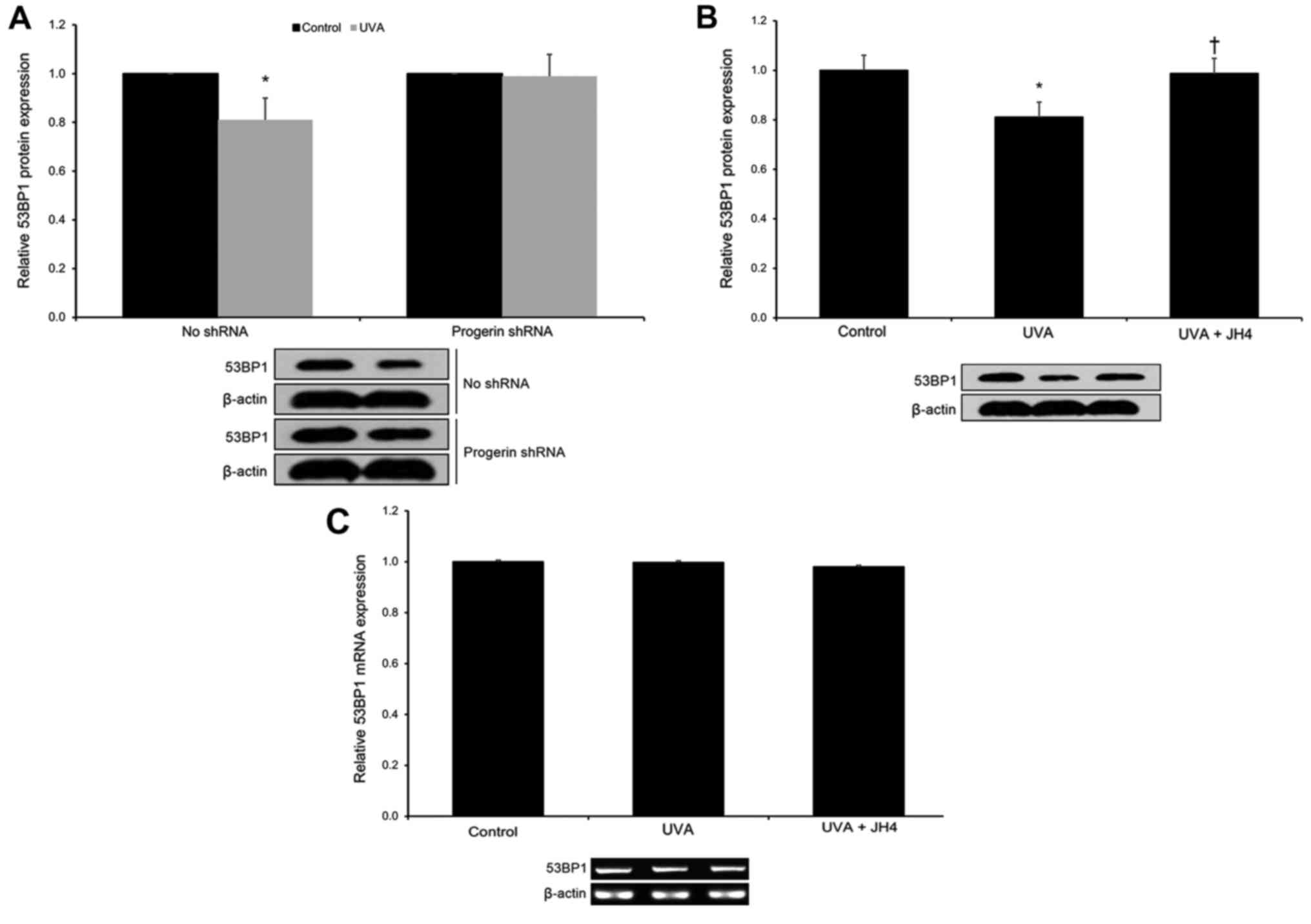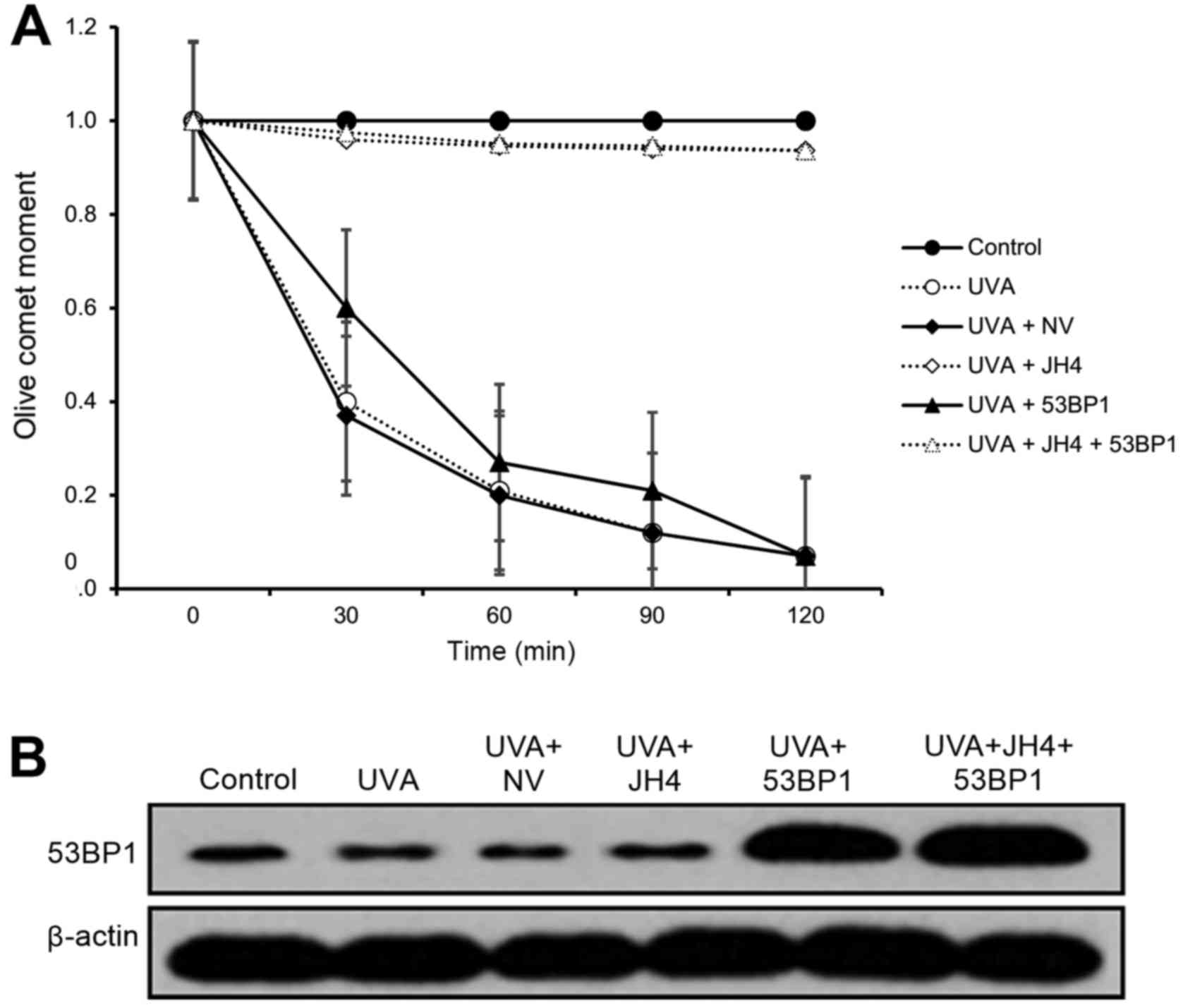|
1
|
Moan J, Grigalavicius M, Baturaite Z,
Dahlback A and Juzeniene A: The relationship between UV exposure
and incidence of skin cancer. Photodermatol Photoimmunol Photomed.
31:26–35. 2015. View Article : Google Scholar : PubMed/NCBI
|
|
2
|
Iannacone MR, Hughes MCB and Green AC:
Effects of sunscreen on skin cancer and photoaging. Photodermatol
Photoimmunol Photomed. 30:55–61. 2014. View Article : Google Scholar : PubMed/NCBI
|
|
3
|
Kabir Y, Seidel R, Mcknight B and Moy R:
DNA repair enzymes: An important role in skin cancer prevention and
reversal of photodamage - a review of the literature. J Drugs
Dermatol. 14:297–303. 2015.PubMed/NCBI
|
|
4
|
Ferlay J, Soerjomataram I, Dikshit R, Eser
S, Mathers C, Rebelo M, Parkin DM, Forman D and Bray F: Cancer
incidence and mortality worldwide: Sources, methods and major
patterns in GLOBOCAN 2012. Int J Cancer. 136:E359–E386. 2015.
View Article : Google Scholar : PubMed/NCBI
|
|
5
|
Schwertman P, Bekker-Jensen S and Mailand
N: Regulation of DNA double-strand break repair by ubiquitin and
ubiquitin-like modifiers. Nat Rev Mol Cell Biol. 17:379–394. 2016.
View Article : Google Scholar : PubMed/NCBI
|
|
6
|
Surovtseva Y, Jairam V, Sundaram R, Bindra
R and Herzon S: A high-throughput, high-content assay for the
discovery of new inhibitors of DNA double-strand break repair.
Cancer Res. 76(Suppl 14): 21742016.doi:
10.1158/1538-7445.AM2016-2174. View Article : Google Scholar
|
|
7
|
Gibbs-Seymour I, Markiewicz E,
Bekker-Jensen S, Mailand N and Hutchison CJ: Lamin A/C-dependent
interaction with 53BP1 promotes cellular responses to DNA damage.
Aging Cell. 14:162–169. 2015. View Article : Google Scholar : PubMed/NCBI
|
|
8
|
Canny M, Wan L, Fradet-Turcotte A,
Orthwein A, Moatti N, Juang YC, Zhang W, Noordermeer SM, Wilson MD,
Vorobyov A, et al: A genetically encoded inhibitor of 53BP1 to 1
stimulate homology-based gene editing. bioRxiv.
0609542016.https://doi.org/10.1101/060954
|
|
9
|
Her SC and Her C: Targeting DNA
double-strand break repair in cancer therapy. J Mol Genet Med.
9:e1062015.
|
|
10
|
Redwood AB, Perkins SM, Vanderwaal RP,
Feng Z, Biehl KJ, Gonzalez-Suarez I, Morgado-Palacin L, Shi W, Sage
J, Roti-Roti JL, et al: A dual role for A-type lamins in DNA
double-strand break repair. Cell Cycle. 10:2549–2560. 2011.
View Article : Google Scholar : PubMed/NCBI
|
|
11
|
Takeuchi H and Rünger TM: Longwave UV
light induces the aging-associated progerin. J Invest Dermatol.
133:1857–1862. 2013. View Article : Google Scholar : PubMed/NCBI
|
|
12
|
Lee SJ, Jung YS, Yoon MH, Kang SM, Oh AY,
Lee JH, Jun SY, Woo TG, Chun HY, Kim SK, et al: Interruption of
progerin-lamin A/C binding ameliorates Hutchinson-Gilford progeria
syndrome phenotype. J Clin Invest. 126:3879–3893. 2016. View Article : Google Scholar : PubMed/NCBI
|
|
13
|
Waldman AS, Chowdhary S, Patrick A, Hersey
M and Waldman BC: The influence of progerin expression on the
nature of DNA double-strand break repair. The FASEB J. 30:(Suppl
1): S576.42016.
|
|
14
|
Mistry DS, Chen Y, Wang Y and Sen GL:
Transcriptional profiling of SNAI2 regulated genes in primary human
keratinocytes. Genom Data. 4:43–46. 2015. View Article : Google Scholar : PubMed/NCBI
|
|
15
|
Malaisse J, Pendaries V, Hontoir F, De
Glas V, van Vlaender D, Simon M, de Rouvroit C Lambert, Poumay Y
and Flamion B: Hyaluronan does not regulate human epidermal
keratinocyte proliferation and differentiation. J Biol Chem.
291:6347–6358. 2016. View Article : Google Scholar : PubMed/NCBI
|
|
16
|
Zhang H, Xiong Z-M and Cao K: Mechanisms
controlling the smooth muscle cell death in progeria via
down-regulation of poly(ADP-ribose) polymerase 1. Proc Natl Acad
Sci USA. 111:pp. E2261–E2270. 2014; View Article : Google Scholar : PubMed/NCBI
|
|
17
|
Woods M, Pant R and Mallya SM: Cyclin D1
and cyclin D-dependent kinases enhance oral keratinocyte
proliferation but do not block keratinocyte differentiation. Int J
Oncol. 37:1471–1475. 2010.PubMed/NCBI
|
|
18
|
Musich PR and Zou Y: DNA-damage
accumulation and replicative arrest in Hutchinson-Gilford progeria
syndrome. Biochem Soc Trans. 39:1764–1769. 2011. View Article : Google Scholar : PubMed/NCBI
|
|
19
|
Miller JD, Ganat YM, Kishinevsky S, Bowman
RL, Liu B, Tu EY, Mandal PK, Vera E, Shim JW, Kriks S, et al: Human
iPSC-based modeling of late-onset disease via progerin-induced
aging. Cell Stem Cell. 13:691–705. 2013. View Article : Google Scholar : PubMed/NCBI
|
|
20
|
Kubben N, Zhang W, Wang L, Voss TC, Yang
J, Qu J, Liu GH and Misteli T: Repression of the antioxidant NRF2
pathway in premature aging. Cell. 165:1361–1374. 2016. View Article : Google Scholar : PubMed/NCBI
|
|
21
|
Kennedy BK: A new connection between VHL
and cancer threads through progerin. Cell Cycle. 12:2721–2722.
2013. View
Article : Google Scholar : PubMed/NCBI
|
|
22
|
Olive M, Harten I, Mitchell R, Beers JK,
Djabali K, Cao K, Erdos MR, Blair C, Funke B, Smoot L, et al:
Cardiovascular pathology in Hutchinson-Gilford progeria:
Correlation with the vascular pathology of aging. Arterioscler
Thromb Vasc Biol. 30:2301–2309. 2010. View Article : Google Scholar : PubMed/NCBI
|
|
23
|
Firoozan S, Takeuchi H and Ruenger T:
Longwave ultraviolet light induces the aging-associated progerin in
melanocytes. Am J Med Genet. 2603:26242006.
|
|
24
|
Gonzalez-Suarez I, Redwood AB, Grotsky DA,
Neumann MA, Cheng EHY, Stewart CL, Dusso A and Gonzalo S: A new
pathway that regulates 53BP1 stability implicates cathepsin L and
vitamin D in DNA repair. EMBO J. 30:3383–3396. 2011. View Article : Google Scholar : PubMed/NCBI
|
|
25
|
Ghosh S, Liu B, Wang Y, Hao Q and Zhou Z:
Lamin A is an endogenous SIRT6 activator and promotes
SIRT6-mediated DNA repair. Cell Reports. 13:1396–1406. 2015.
View Article : Google Scholar : PubMed/NCBI
|
|
26
|
Mao Z, Hine C, Tian X, van Meter M, Au M,
Vaidya A, Seluanov A and Gorbunova V: SIRT6 promotes DNA repair
under stress by activating PARP1. Science. 332:1443–1446. 2011.
View Article : Google Scholar : PubMed/NCBI
|



